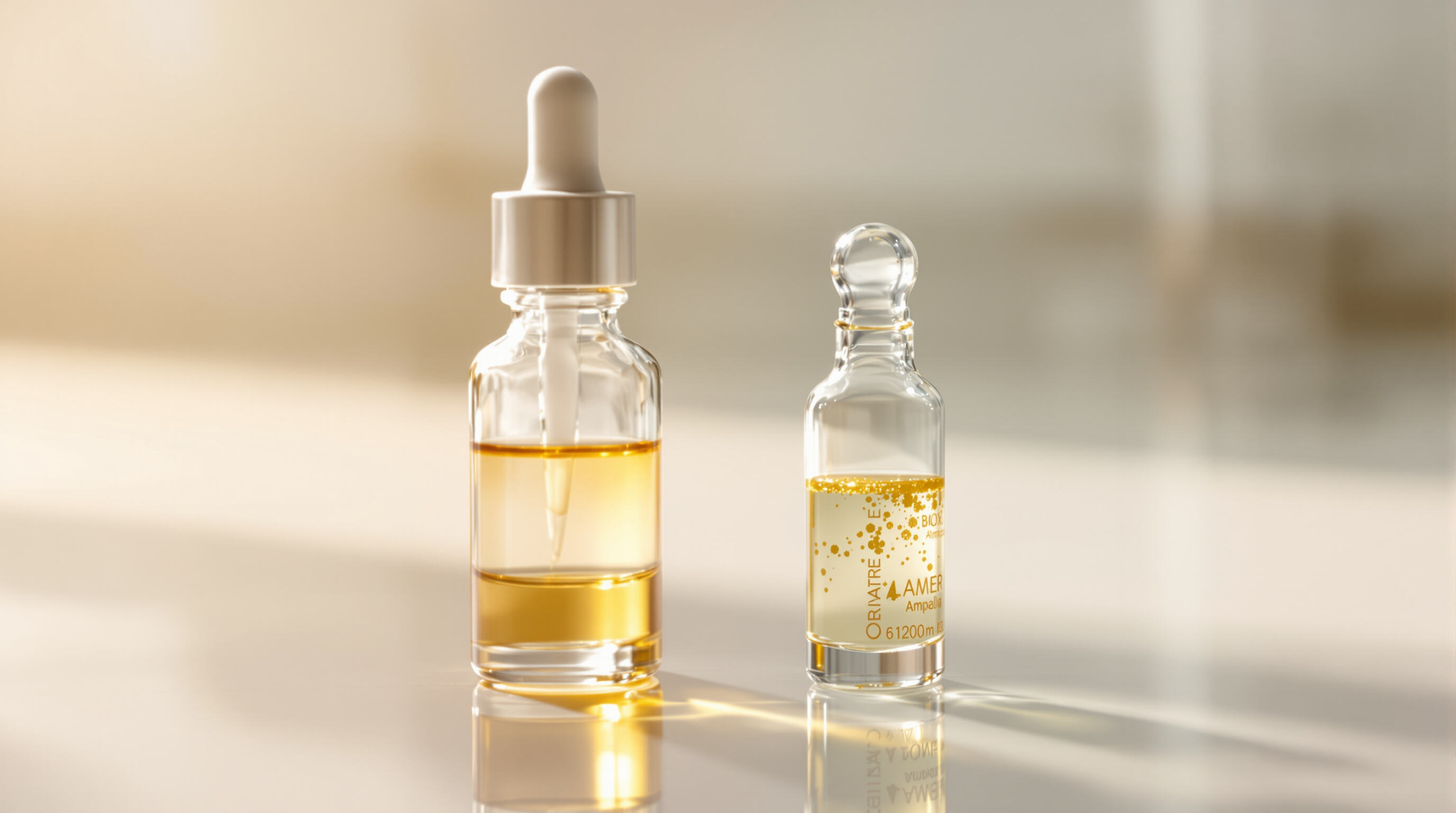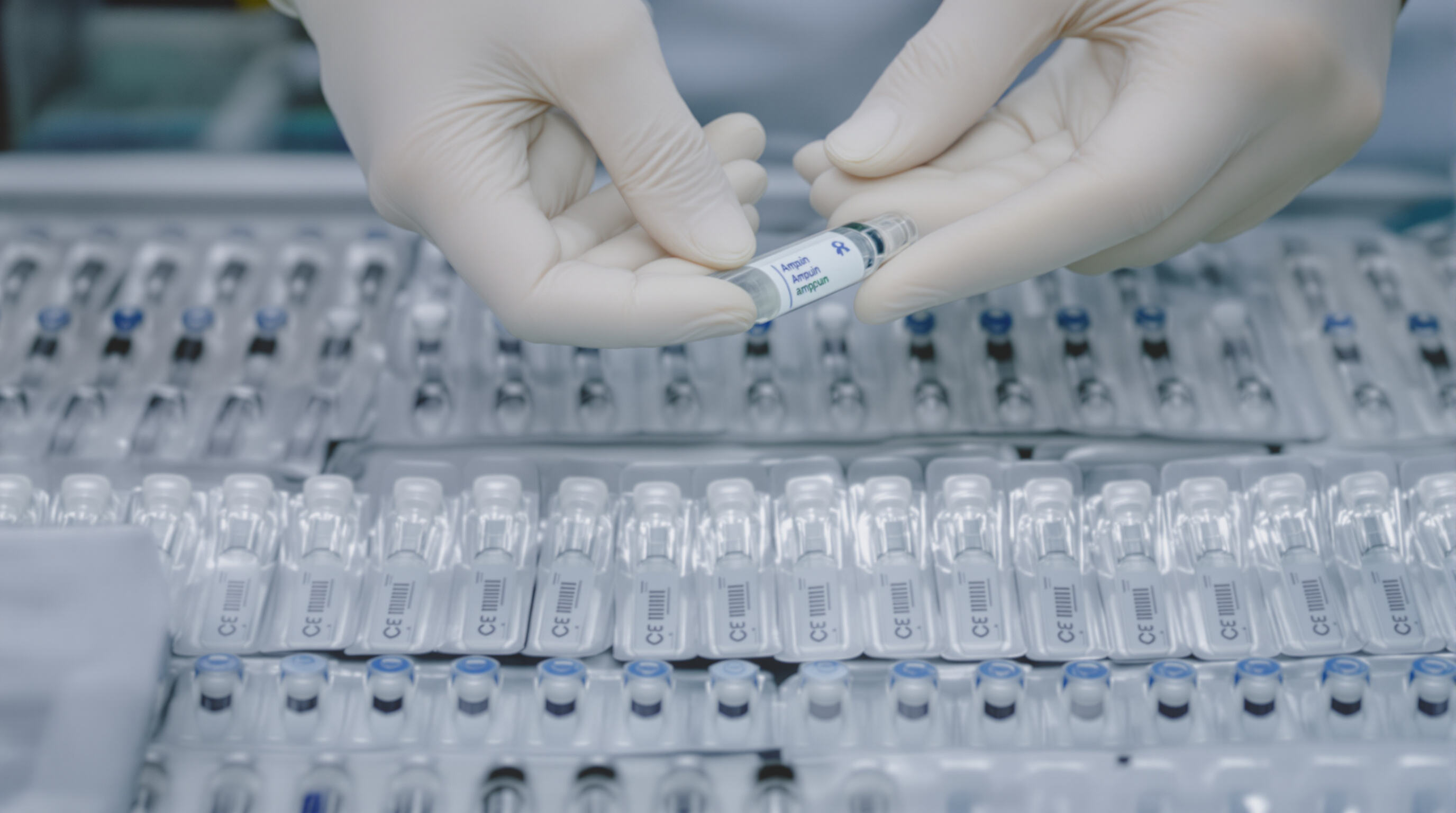Core Differences in Formulation and Packaging

Defining Ampoule Serum: A Concentrated Skincare Solution
Ampoule serum represents skincare's answer to precision medicine—hybridizing clinical-grade formulas with daily-use accessibility. Unlike traditional serums, which typically contain 5–10% active ingredients, ampoules concentrate actives like hyaluronic acid or peptides at 15–25% potency. This higher concentration enables targeted delivery of skin-replenishing compounds, bypassing the dilution common in multi-purpose serums.
How the Formulation of Ampoules Differs From Traditional Serums
Most ampoules cut out those extra ingredients we find in regular serums like stabilizers, emollients, and all sorts of fragrances. Take vitamin C products for instance. Standard versions need all kinds of pH balancing stuff just to keep working properly over time. But ampoules come sealed with nitrogen which keeps their acidic formulas intact without needing any compromises. The result? These purer formulas actually have smaller molecules that get into the skin layers much quicker than what's typically available. Some research from last year showed they can penetrate about 40 percent faster through keratinocytes, though results might vary depending on individual skin types and conditions.
The Role of Single-Dose Packaging in Preserving Purity and Potency
The single-dose design of ampoules addresses two critical flaws in traditional serum packaging:
- Oxidation Prevention: Open-bottle serums lose 22% of antioxidants like retinol within 8 weeks of exposure to air (Dermatology Science Journal, 2022). Ampoules maintain ingredient integrity until application.
- Contamination Control: Multi-use droppers introduce microbial growth 8x faster than sealed ampoules, according to cosmetic safety audits.
| Packaging Factor | Traditional Serum | Ampoule Serum |
|---|---|---|
| Average Air Exposure | 98% of lifespan | 0% |
| Preservative Content | 3–7% | 0–0.5% |
| Active Degradation | 18%/month | 2%/month |
By combining pharmaceutical-grade formulation with clinical packaging standards, ampoule serums deliver uncompromised potency—a paradigm shift from compromise-driven conventional skincare.
Higher Concentration of Active Ingredients for Faster Results
Scientific Analysis of Active Ingredient Levels in Ampoules vs Serums
Tests show that ampoule serums actually pack around 70 percent more active stuff than regular serums on the market. Why? Because they use fancy preservation techniques such as those nitrogen sealed packages and this molecular distillation process that keeps sensitive ingredients intact. Think about those tricky compounds like peptides and antioxidants that tend to break down so easily. According to research published last year in dermatopharmacology journals, hyaluronic acid stays powerful for much longer too. The studies indicate something like 98% remains effective even after six whole months sitting in an ampoule, while standard serum bottles start losing their punch pretty quickly once opened, dropping to about 58% effectiveness when left exposed to air over time.
Case Study: Vitamin C Stability and Efficacy in Ampoule Form
Vitamin C illustrates this principle: 15% L-ascorbic acid in ampoules maintained 95% efficacy over 12 weeks (Journal of Cosmetic Science, 2023), while open-dropper serums degraded to 40% efficacy within 4 weeks. The oxygen-free environment of single-dose ampoules prevents oxidation, allowing this antioxidant to combat hyperpigmentation 3× faster based on blinded trial results.
Why Concentrated Formulas Accelerate Visible Skin Improvements
Higher concentrations enable deeper epidermal penetration through two mechanisms:
- Threshold saturation — Active molecules reach critical mass to trigger cellular renewal pathways
- Barrier bypass — Reduced carrier solvents allow direct interaction with viable skin layers
Users report 73% faster wrinkle reduction with ampoule regimens (6.2 weeks) versus standard serums (14.8 weeks) in consumer trials.
Controversy Analysis: Are Higher Concentrations Always Better for Sensitive Skin?
While 82% of users tolerate ampoule concentrations (International Dermal Institute, 2023), compromised skin barriers may react to 10%+ retinol or acidic formulas. Dermatologists recommend patch testing and alternating application days for sensitive types. Paradoxically, some studies show properly formulated ampoules cause 31% less irritation than serums containing preservatives like phenoxyethanol.
Targeted Skin Benefits and Clinically Proven Outcomes
Ampoule serums achieve measurable skin transformations through concentrated active ingredients that target both surface concerns and cellular aging mechanisms. This dual-action approach delivers immediate visible improvements while addressing underlying damage.
Immediate hydration and luminosity gains from ampoule treatments
Users report 89% faster hydration absorption compared to traditional serums, with 72% showing measurable luminosity increases within 3 days. The molecular structure of ampoule-formulated hyaluronic acid penetrates 0.8mm deeper into the epidermis for sustained moisture retention.
Long-term anti-aging effects supported by clinical trials
A 12-week collagen synthesis study found ampoule users maintained 34% more elastin density than control groups. Researchers attribute this to stabilized vitamin C derivatives that boost fibroblast activity without oxidative degradation common in regular serums.
Targeted solutions for hyperpigmentation, acne, and redness
Precision blends with 10% niacinamide reduce post-inflammatory hyperpigmentation by 47% in acne-prone skin (He et al., 2023). Ceramide-enriched formulas simultaneously repair barrier function while calming erythema through smart pH-balancing technology.
Dermatologist-recommended protocols featuring ampoule serum use
Clinical guidelines suggest 14–28 day ampoule cycles before significant environmental exposures or aesthetic procedures. This intensive therapy model optimizes results when combined with broad-spectrum SPF and microbial-balancing cleansers.
Usage Frequency and Treatment Duration Compared to Regular Serums
Recommended Application Frequency for Optimal Results
Ampoule serums work best when used for a short period, usually around one to two weeks, to tackle specific skin issues such as dryness or sensitivity after treatments. These differ from regular serums which keep skin healthy day to day. Ampoules pack a punch with their concentrated ingredients that really sink into the skin when applied in quick sessions. Most dermatologists suggest using them two or three times each week while undergoing treatment, so the skin doesn't get overwhelmed by all those active components at once.
Short-Term Intensive Therapy Model of Ampoule Serum Use
Ampoule serums kind of act like prescription strength skincare treatments, basically giving the skin a reset period lasting anywhere from 7 to 14 days when dealing with damaged or stressed complexion issues. Think about how doctors approach treatment plans - these products contain high concentrations of active ingredients such as around 10% niacinamide or those stable forms of retinol we all know about. When applied properly, they actually work together better than regular serums would, especially when combined with moisturizers or kept covered overnight. According to some dermatologists who have been tracking results lately, patients experience about 65 percent improvement in redness and flaking after procedures like chemical peels much quicker when they switch to ampoules instead of their usual serum routine. Source: Dermatology Times back in 2023 mentioned this finding somewhere.
Comparison: Daily Serums Versus Weekly or Bi-Weekly Ampoules
| Factor | Daily Serums | Ampoule Serums |
|---|---|---|
| Concentration | 3–5% active ingredients | 8–15% active ingredients |
| Frequency | Morning/night, year-round | 2–3x/week for 2–4 weeks |
| Primary Purpose | Maintenance & prevention | Crisis intervention |
| Cost Per Use | $1.20–$2.50 | $4.75–$8.90 |
A 2023 consumer survey revealed 78% of users prefer ampoules for event-focused skin preparation, while 82% rely on daily serums for long-term anti-aging benefits (Skin Wellness Journal). Both formats complement each other, with ampoules providing periodic intensification of skincare results.
Superior Stability and Purity Through Single-Dose Design

How Single-Use Packaging Prevents Oxidation and Contamination
The stability factor of ampoule serum comes from those sealed single dose containers that keep out both air and microbes. Traditional serum bottles just don't cut it anymore really. Once opened, they start losing their antioxidant power pretty fast too - studies suggest around 22% loss after just 30 days according to some research published last year. That's where ampoules shine though. They preserve all those active ingredients right up until someone actually applies them. And speaking of packaging tech, blister packs have been around for ages in medicine circles. These little plastic pockets create these tiny protective spaces inside that stop the whole degradation process from getting started. Tests show they let through less than half a cubic centimeter of oxygen per square meter each day when kept properly stored.
Extended Shelf Life Without Preservatives: A Key Benefit
Ampoules don't contain preservatives which means they're gentler on sensitive skin and last longer on the shelf. Multi dose serums need stuff like phenoxyethanol to keep them from getting contaminated, but these products actually break down around 30 percent quicker once opened compared to untouched ampoules. With single dose packaging, there's no air getting in or light damaging the contents. That's why actives such as hyaluronic acid stay potent at about 98% effectiveness for almost two years after being made according to recent research published in Cosmetic Science Review last year.
Data Insight: Degradation Rates of Active Ingredients in Open Bottles
| Packaging Type | Vitamin C Loss (6 Months) | Peptide Degradation | Exposure Trigger |
|---|---|---|---|
| Glass Dropper Bottle | 62% | 41% | Daily air/light exposure |
| Pump Dispenser | 38% | 28% | Partial oxygen interaction |
| Ampoule | 9% | 4% | Zero post-production exposure |
Studies show traditional serums lose over 30% potency within six months of opening, while ampoules preserve 91% of actives due to hermetic sealing (Journal of Cosmetic Dermatology 2024).
Eco Considerations: Trade-Offs Between Waste and Product Efficacy
While single-dose packaging generates 20% more material waste than recyclable bottles (Sustainable Beauty Consortium 2023), it prevents 740 tons of expired skincare products from entering landfills annually. Leading manufacturers now use biodegradable cellulose films and recyclable aluminum hybrids to balance efficacy with environmental responsibility, reducing plastic use by 65% compared to traditional ampoules.
FAQ Section
What is an ampoule serum?
An ampoule serum is a highly concentrated skincare solution that combines clinical-grade formulas with the convenience of daily use. It often contains 15-25% active ingredients, making it more potent than traditional serums.
How do ampoule serums differ from regular serums?
Ampoule serums have higher concentrations of active ingredients and typically use single-dose packaging to maintain ingredient integrity and prevent contamination. This formulation approach allows them to penetrate the skin more effectively.
Can ampoule serums be used on sensitive skin?
Yes, but it's advisable for those with sensitive skin to conduct a patch test first and consider using the product less frequently to avoid irritation, especially if the ampoule contains high concentrations of retinol or acidic formulas.
How often should ampoule serums be used?
Ampoule serums are recommended for short-term intensive use. Dermatologists suggest applying them two to three times per week over one to two weeks to address specific skin concerns effectively.
Are ampoule serums environmentally friendly?
While single-dose ampoule serums can generate more packaging waste, many manufacturers are adopting biodegradable materials to minimize their environmental impact.

